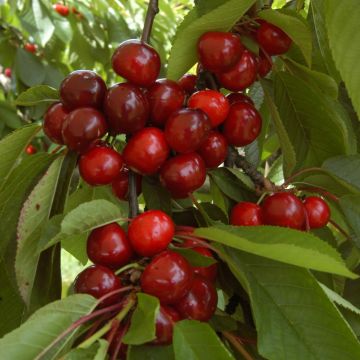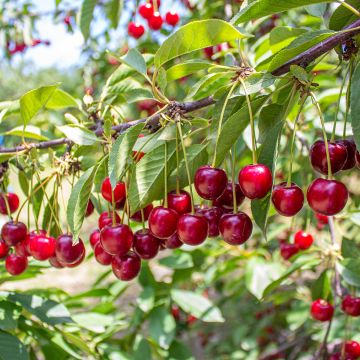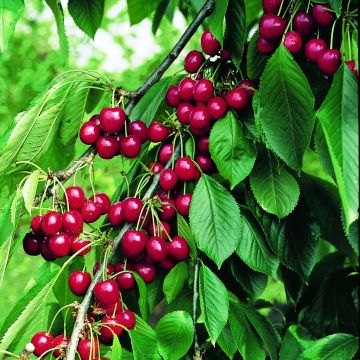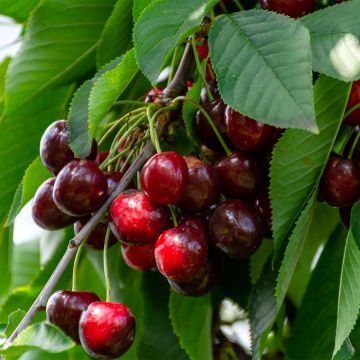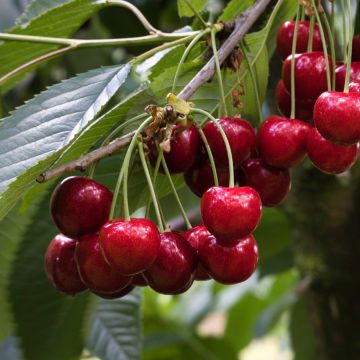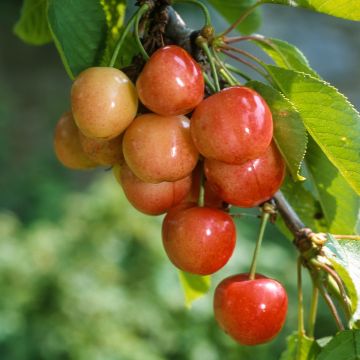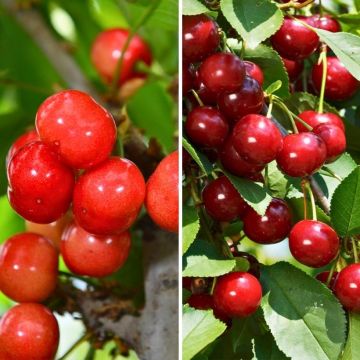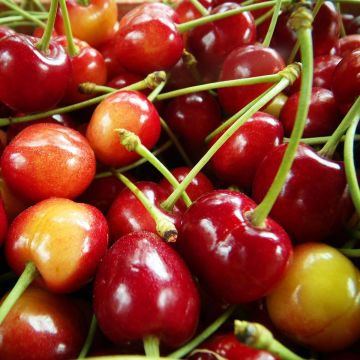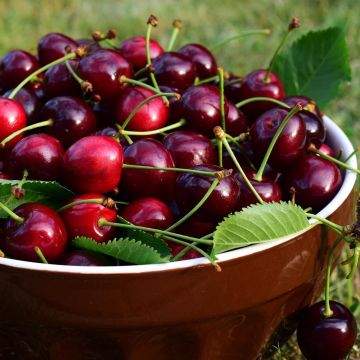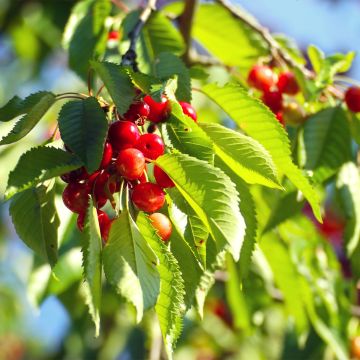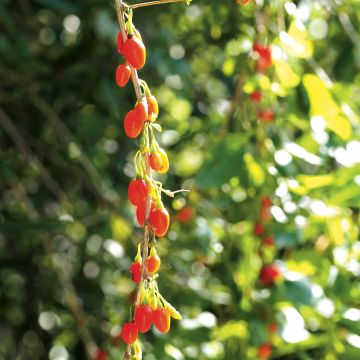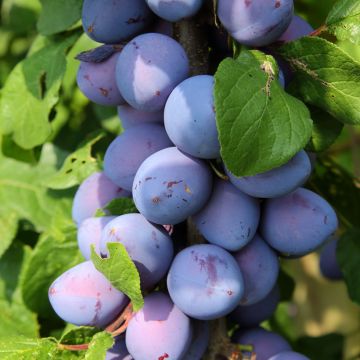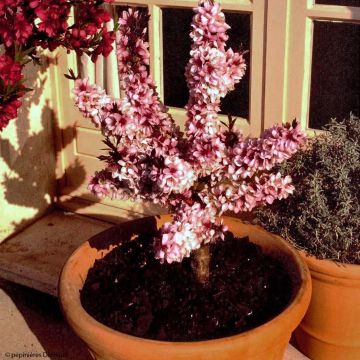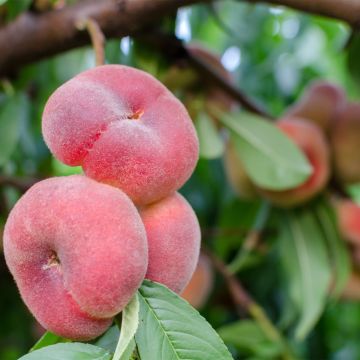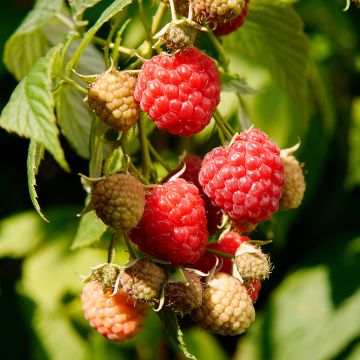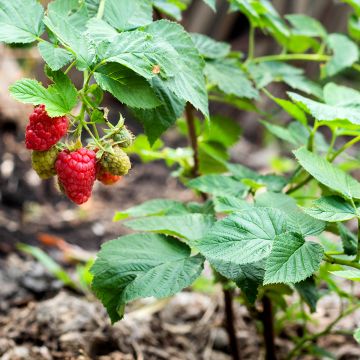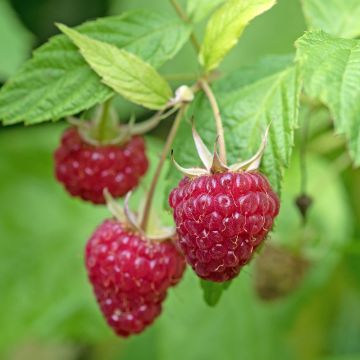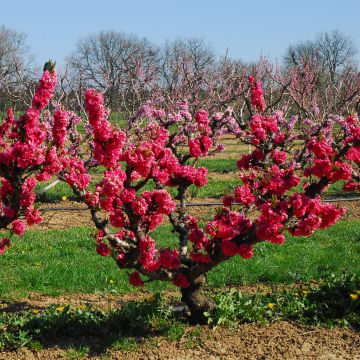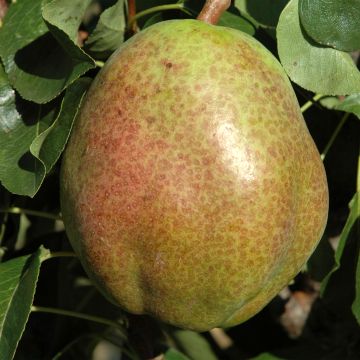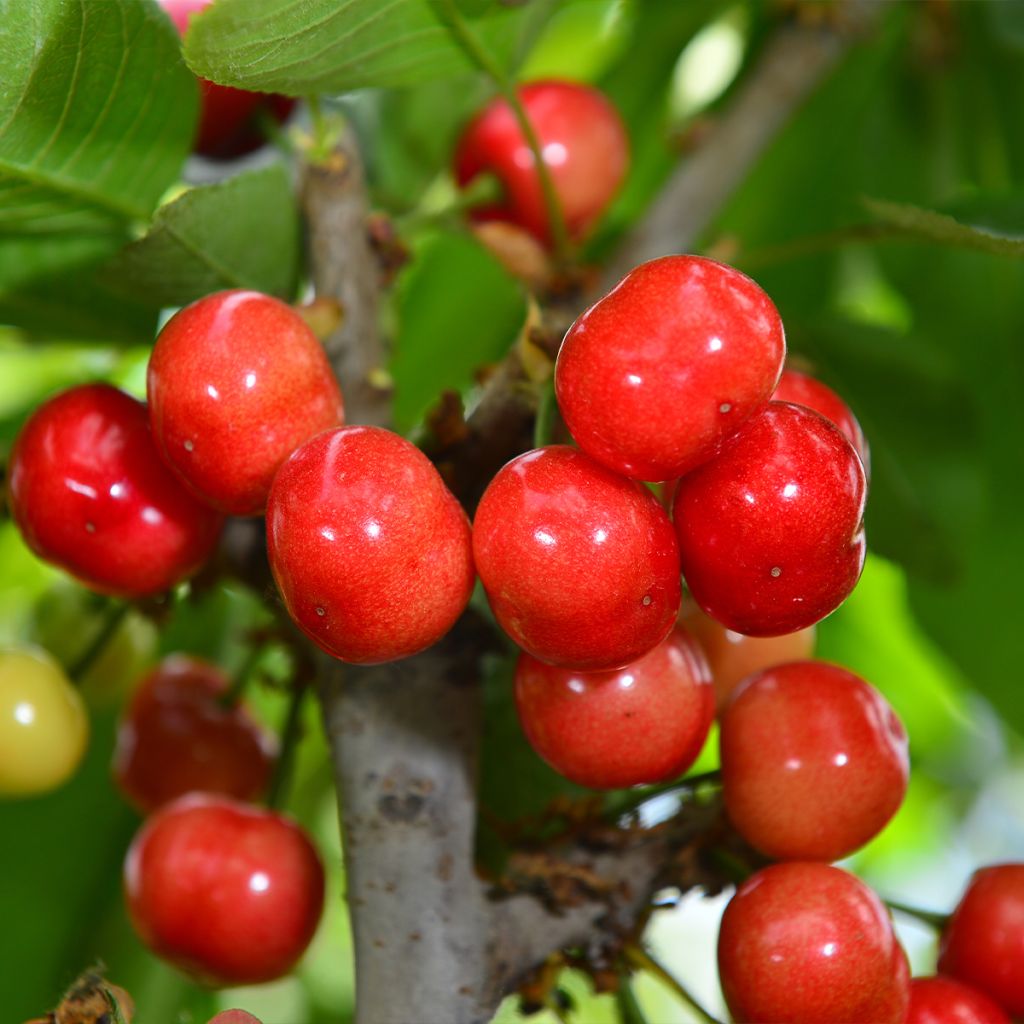

Prunus cerasus Hong kong - Tart Cherry Tree
Prunus cerasus Hong kong - Tart Cherry Tree
Prunus cerasus Hong kong
Sour Cherry, Tart Cherry, Dwarf Cherry, Morello Cherry
This item cannot be shipped to the selected country
Oversize package delivery charge from €6.90
Delivery to Corse prohibited
More information
Schedule delivery date,
and select date in basket
This plant carries a 6 months recovery warranty
More information
We guarantee the quality of our plants for a full growing cycle, and will replace at our expense any plant that fails to recover under normal climatic and planting conditions.
Oversize package: home delivery by special carrier from €6.90 per order..
Express home delivery from €8.90.
Delivery to Corse prohibited: UE law prohibits the import of this plant from mainland France to Corse as part of the fight against Xylella fastidiosa. Please accept our sincere apologies.
More information

Description
Prunus cerasus 'Hong Kong' is a variety of cherry tree that is ideal for small gardens. With its columnar habit and compact size (3 to 4m (10 to 13ft) tall), it can even be grown in a container on a patio. Its highly decorative white flowering in April evolves into beautiful bright red, crisp and sweet cherries. It bears fruit after 2 to 3 years of planting, and it is a self-fertile variety that does not need another cherry tree in the garden to bear fruit. It adapts to most soils and is tolerant to watering (except during periods of high heat). This variety is resistant to diseases.
Prunus cerasus (also known as sour cherry) and the sweet cherry P. avium are the two main species that have given rise to most of the sweet fruit cherries cultivated in our gardens. They belong to the Rosaceae family, one of the most important under our latitudes, both for fruit and ornamental gardens, as well as for wild flora. It is a medium-sized tree, reaching 5 to 10m (16 to 33ft) in height at maturity. Its rounded habit provides a beautiful shaded space, which is very pleasant during summer. Its alternate and toothed leaves are shiny and dark green, turning a beautiful reddish colour in autumn before falling. Cherries are rich in vitamin C, minerals, and trace elements.
'Hong Kong' forms a small tree with a columnar habit, reaching 3 to 4m (10 to 13ft) in height and only 60cm (24in) in width. In April, it is covered with an abundance of white flowers, rivalling flowering cherry trees. After pollination by insects, they produce beautiful bright red, sweet and crisp cherries. Harvesting starts in the 2nd or 3rd year of planting (fruit production becomes optimal after 5 to 7 years). Cherries should be picked when fully ripe, as they do not ripen after harvest.
This cherry tree can be planted in most garden soils, tolerating acidity and limestone without excess. Once rooted, it is also tolerant to watering, but occasional watering is always useful, especially during extended hot periods. It will need regular watering if planted in a container, as the growing conditions are much drier than in open ground and the plant cannot access water from the soil. This hardy variety can withstand temperatures down to -20°C (-4°F). It requires staking. It only needs light pruning to maintain its narrow habit. Stone fruit trees do not appreciate pruning, as it can trigger gummosis, a resin production in response to stress. Therefore, it is best to simply shorten the tips of green shoots in early August. Another important precaution is to check the stakes every year to avoid strangling the trunk. Rubber ties should be used. Regularly loosen the soil to avoid hindering the growth of the main axis.
It can be planted on a lawn, at the back of a bed, or in an orchard. It is important to be vigilant in spring, as the flowering is very sensitive to frost (damage can occur at -2°C (28.4°F)). Thanks to its columnar shape, this variety is very easy to protect by using a non-woven fabric cover with a density of 30 g/m² to wrap around the foliage. 'Hong Kong' can be mixed with ornamental plants in a diverse bed, leaving sufficient space around it to allow light to reach the fruits and to enable easy picking. Low-growing shrubs will be good companions, such as Japanese Spirea 'Crispa', an ornamental plant with pink flowers in summer. You can also create a small orchard in a limited space by planting small fruits such as currants or gooseberries nearby.
Report an error about the product description
Prunus cerasus Hong kong - Tart Cherry Tree in pictures


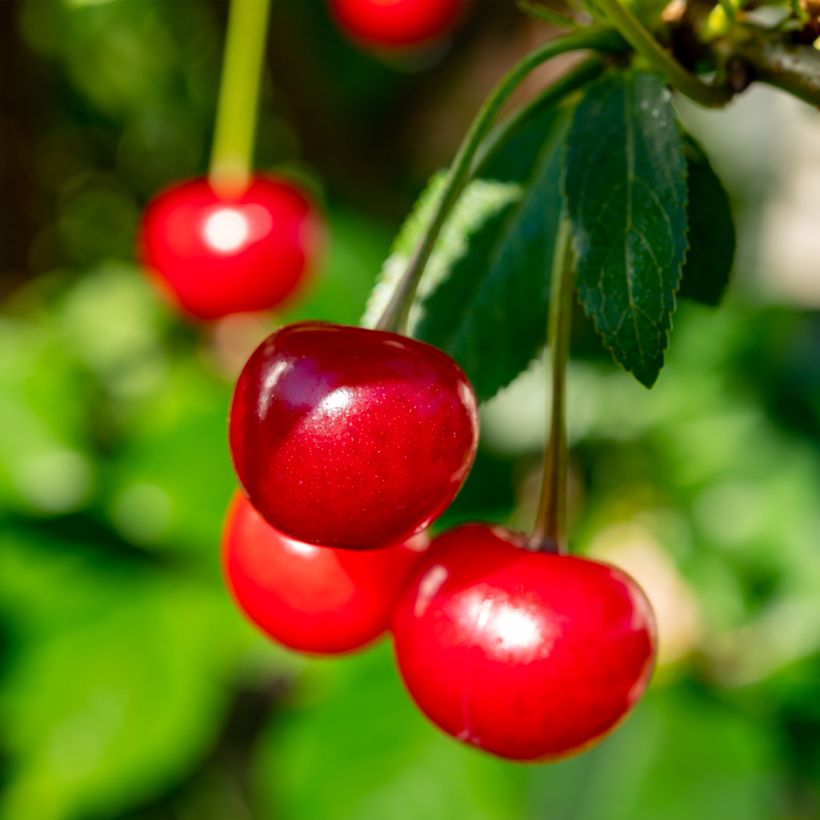

Plant habit
Fruit
Flowering
Foliage
Botanical data
Prunus
cerasus
Hong kong
Rosaceae
Sour Cherry, Tart Cherry, Dwarf Cherry, Morello Cherry
Cultivar or hybrid
Other Cherry trees
Planting and care
It is easy to grow in all types of soil, whether acidic or chalky. It appreciates moist, light soils, and fears heavy and clayey ones. Choose a sunny exposure. Plant the tree in a sheltered position, facing west. Protect it from cold winds in regions that experience spring frosts. A sheltered area will also reduce the risk of late frost damaging the flowers. Ideally, plant in autumn.
Loosen the soil deeply, and remove stones and weeds. Add some sand to improve drainage. Dig a hole 4 to 5 times the volume of the root ball. Separate the subsoil from the topsoil. Mix crushed horn or well-rotted compost or potting soil with the subsoil and pour this mixture into the planting hole. Install a stake, then place the root ball, cover with topsoil, and firm it down. Water generously. Attach the stake to the plant, crossing the tie in the shape of an 8, without tightening around the trunk to allow it to grow without being strangled (to be monitored over the years).
Watering is not essential during cultivation, but is necessary in case of high temperatures, especially in hot regions. Regular watering is required if you grow 'Hong Kong' in a container, as your tree will not be able to draw from the soil as it would in open ground. Mulch at the base to retain moisture in summer.
Protect your harvest by installing a bird net.
In case of aphid attack, spray diluted black soap in water.
Planting period
Intended location
Care
-
, onOrder confirmed
Reply from on Promesse de fleurs
Fruit trees for small gardens
Haven't found what you were looking for?
Hardiness is the lowest winter temperature a plant can endure without suffering serious damage or even dying. However, hardiness is affected by location (a sheltered area, such as a patio), protection (winter cover) and soil type (hardiness is improved by well-drained soil).

Photo Sharing Terms & Conditions
In order to encourage gardeners to interact and share their experiences, Promesse de fleurs offers various media enabling content to be uploaded onto its Site - in particular via the ‘Photo sharing’ module.
The User agrees to refrain from:
- Posting any content that is illegal, prejudicial, insulting, racist, inciteful to hatred, revisionist, contrary to public decency, that infringes on privacy or on the privacy rights of third parties, in particular the publicity rights of persons and goods, intellectual property rights, or the right to privacy.
- Submitting content on behalf of a third party;
- Impersonate the identity of a third party and/or publish any personal information about a third party;
In general, the User undertakes to refrain from any unethical behaviour.
All Content (in particular text, comments, files, images, photos, videos, creative works, etc.), which may be subject to property or intellectual property rights, image or other private rights, shall remain the property of the User, subject to the limited rights granted by the terms of the licence granted by Promesse de fleurs as stated below. Users are at liberty to publish or not to publish such Content on the Site, notably via the ‘Photo Sharing’ facility, and accept that this Content shall be made public and freely accessible, notably on the Internet.
Users further acknowledge, undertake to have ,and guarantee that they hold all necessary rights and permissions to publish such material on the Site, in particular with regard to the legislation in force pertaining to any privacy, property, intellectual property, image, or contractual rights, or rights of any other nature. By publishing such Content on the Site, Users acknowledge accepting full liability as publishers of the Content within the meaning of the law, and grant Promesse de fleurs, free of charge, an inclusive, worldwide licence for the said Content for the entire duration of its publication, including all reproduction, representation, up/downloading, displaying, performing, transmission, and storage rights.
Users also grant permission for their name to be linked to the Content and accept that this link may not always be made available.
By engaging in posting material, Users consent to their Content becoming automatically accessible on the Internet, in particular on other sites and/or blogs and/or web pages of the Promesse de fleurs site, including in particular social pages and the Promesse de fleurs catalogue.
Users may secure the removal of entrusted content free of charge by issuing a simple request via our contact form.
The flowering period indicated on our website applies to countries and regions located in USDA zone 8 (France, the United Kingdom, Ireland, the Netherlands, etc.)
It will vary according to where you live:
- In zones 9 to 10 (Italy, Spain, Greece, etc.), flowering will occur about 2 to 4 weeks earlier.
- In zones 6 to 7 (Germany, Poland, Slovenia, and lower mountainous regions), flowering will be delayed by 2 to 3 weeks.
- In zone 5 (Central Europe, Scandinavia), blooming will be delayed by 3 to 5 weeks.
In temperate climates, pruning of spring-flowering shrubs (forsythia, spireas, etc.) should be done just after flowering.
Pruning of summer-flowering shrubs (Indian Lilac, Perovskia, etc.) can be done in winter or spring.
In cold regions as well as with frost-sensitive plants, avoid pruning too early when severe frosts may still occur.
The planting period indicated on our website applies to countries and regions located in USDA zone 8 (France, United Kingdom, Ireland, Netherlands).
It will vary according to where you live:
- In Mediterranean zones (Marseille, Madrid, Milan, etc.), autumn and winter are the best planting periods.
- In continental zones (Strasbourg, Munich, Vienna, etc.), delay planting by 2 to 3 weeks in spring and bring it forward by 2 to 4 weeks in autumn.
- In mountainous regions (the Alps, Pyrenees, Carpathians, etc.), it is best to plant in late spring (May-June) or late summer (August-September).
The harvesting period indicated on our website applies to countries and regions in USDA zone 8 (France, England, Ireland, the Netherlands).
In colder areas (Scandinavia, Poland, Austria...) fruit and vegetable harvests are likely to be delayed by 3-4 weeks.
In warmer areas (Italy, Spain, Greece, etc.), harvesting will probably take place earlier, depending on weather conditions.
The sowing periods indicated on our website apply to countries and regions within USDA Zone 8 (France, UK, Ireland, Netherlands).
In colder areas (Scandinavia, Poland, Austria...), delay any outdoor sowing by 3-4 weeks, or sow under glass.
In warmer climes (Italy, Spain, Greece, etc.), bring outdoor sowing forward by a few weeks.

































